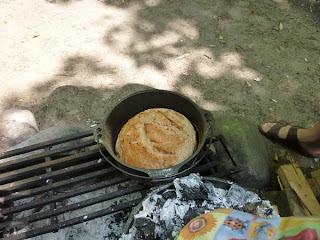Camp Bread #5:
A Spent Sourdough Rye, Multigrain and All Purpose Bread Baked in a Dutch Oven by Paul
Dough:
- 1/2 c rye flour
- 2 1/2 c multigrain flour
- 1 1/2 c all purpose flour
- 1 tsp yeast
- 1/2-3/4 c old sourdough starter
- 1 1/2 c potato water (+1/4 c + 1/4 c added during mixing)
- 1 1/2 tsp salt
Method:
At about 4 p.m. my son Paul mixed up this dough. He had smelled some of my leftover sourdough bread, comparing it to the all purpose loaf of the day before, and he said he found the sourdough version smelled more interesting. For that reason, he decided to use a similar recipe for his bread. Once again we followed the outline of the Sourdough Discard Bread Recipe. This time we were using real sourdough discard, unrefreshed; it would be more sour, but that was okay, we didn't have quite as much. We had some potato water to use up, and I personally think that he put in lots of salt, although he didn't think so. We still don't have measuring spoons to arbitrate discussions.
I told him that the longer the dough rose, the more flavour it would have, and he decided to not bake it that night. It sat in the car, the coolness of the summer evening the equivalent of retarding the dough in the refrigerator. In the morning it was removed and placed in a prominent spot out of the way of critters and people, and it appeared to have tripled. Around noon, when we were all around having lunch, a fire was started.
Paul removed the dough from the container and folded it once, envelope style. It seemed to have good elastic properties. Then he lifted it with wet hands and formed a boule, making the gluten sheath nice and tight, at the same time not overhandling it. He placed it on the couche with rye flour dusted on it, and the dough was covered to rise while the fire burned down.
Once we had some coals, we preheated the Dutch Oven 30 minutes and the dough was placed in the pot.
After 25 minutes the pot was still in the coals but rotated once, the lid was removed for a peak at the top. It was a nice, honey-coloured crust already, the scent was of a strong sourdough that Paul identified as "nutty".
He elected to remove the Oven from the direct heat, but to keep the loaf in the pot and place more coals on the top lid. After 5 minutes he looked again, and his mother advised him to bake it as long as possible. He left it another 10 minutes, and then turned it out onto a grill to cool.
There was one darkened, burnt area on the bottom, but overall Paul was pleased with the way his bread looks.
I thought it tasted great. Others who tried it said they liked it too. A few people were skeptical about the scent of the sourdough, but it didn't taste all that sour to me.
Notes to Myself
- Paul's loaf is the best loaf baked, by far: the coals were hot, and retained a lot of heat throughout the preheating and baking stages. Paul used a lot of coals for the top lid, a very good idea.
- Better would have been fresher sourdough starter, so the bread would have tasted a little less sour. Not everyone liked it because it is sour.
- It might be impossible to work out accurately the precise hydration of this loaf, but I suspect that the reason Paul's loaf was nicely browned on its crust was due to its higher hydration. The extra 1/2 c of potato water really helped, as did sprinkling some water on the top of the loaf when it first is put into the oven.













No comments:
Post a Comment